How can photography represent the realities or truth of war?
“Photography cannot change the world, but it can show the world, especially when it changes.”
– Marc Riboud
Within my study I will explore the lives of German soldiers stationed at La Corbiere. Using a combination of both tableaux and documentary approaches to photography, I will depict their lives as they lived them in their fortifications. For my inspiration, the artists I have chosen are Paul M. Smith, a UK artist behind the series ‘Artist Rifles’ (1995) and Michiel Peeters, a Belgian photographer who, through re-enacting archive images, creatively visualises and re-tells the lives of soldiers of the Second World War. Both artists share the theme of war, however through their depictions, varies greatly in the meanings and purpose behind them. As stated by Sontag in ‘Plato’s cave’ ‘Photographed images do not seem to be statements about the world so much as pieces of it, miniatures of reality that anyone can make or acquire.’,1 I find this applicable to both of my artists within their respective genres and interpretations of the theme of ‘war’. In my eyes, Smith’s work falls into the artisanal category, using himself as the subject behind photoshopped scenarios, which can be analysed to reflect his own experiences involving the military. Peeters’ work on the other hand, focuses more-so on the observational aspects of documentary photography, creating a tableaux to re-tell events surrounding areas of historical significance in Belgium and France.
Through both interpretations of war, I find it interesting to see how both explore the subject, in either a personal or educational manner. For my project I would like to recreate some original images of the Germans soldiers’ stories I’m visualising. To do this, I will edit them to appear in a similar manner to the quality and feel of the vintage film aesthetic. In addition to this, I would also like to create that de-saturated grittiness of Peeters photographs, as I feel it creates a sense of realistic immersion. From correspondence with Peeters himself, he told me, ‘my inspiration comes more from movies and TV than other photographers, such as with Band of Brothers, Saving Private Ryan, the Longest Day, and some others.’2. To merge these two aesthetics – photography and cinema – I will include filler images that fade like a gradient between them. For some of these filler images I will include some landscape shots of Corbiere, this will show elements of formalism as unlike the images of myself they do no not intend to show any emotion or context, but rather just inform the setting in which the photos take place.
With the subject of war, being associated to the thoughts of death and violence, I find these artists in their respective ways, present the side of humanity which can be found in those who were involved; their stories and experiences. Applying similar photographic methods and techniques, I wish to combine the two, to present a personal interpretation and to educate people on the lives of some of those stationed within Jersey during the Second World War. With scars of the war still residing through concrete emplacements along our Islands coast, this also creates the personal factor of heritage and history, which I wish to remind and educate viewers about a pinnacle point in our local history. Through these artists, I find that they will inspire me to create an informative and unique take on documenting history that reflects both on their creative qualities of editing. Using photoshop skills I have picked up during my studies, I feel I have a good basis on how I can go about creating my project.
During the period of the occupation, many soldiers on the island were found cut off from mainland Europe, with limited ways to communicate to their families. Soldiers like Engelbert Hoppe found it a hard time to be away for so long. Like the islanders, many soldiers also felt imprisoned. For this reason, I wish to capture these stories within my photographs. Through my study into photographic art movements and approaches to image-making, I find that tableaux is the most applicable to my work. The origin of tableaux in photography as an aesthetic style is rooted in pictorialism, which emerged in the late 19th century and was the first attempt to consider photography and artistic expression. Performed in plays, Tableaux vivant was an early form of its place within art. Performed in theatres, actors would form visualisations of the past such as live recreations of historic paintings through costumes. In its simplest form, Tableaux can be used to convey a pictorial narrative through staged images.
With my approach to interpreting the German soldiers stories (through a personal expression of my passion for history), I find that through tableaux, I wish to create a representation of the lives of the often-generalised enemy. With the German people forced to serve by their fascist government, the unlucky young population that did not conform was what made up some of the men from 2nd Company of MG Battalion 16.
In Susan Sontag’s ‘Plato’s Cave’ she speaks of the use of photography in war, with its initial use to document progression of battles and victories it eventually became a source of capturing the visual horrors and atrocities of war. Sontag examples this through the controversial Vietnam War. Unlike prior conflicts, such as the Second World War when the United States were fighting for a “just cause of the free world”, the conflict in Vietnam was a proxy-war of political ideologies, ‘No one brought back photographs of daily life in Pyongyang, to show that the enemy had a human face’.3 Artists that did so include the likes of Nick Ut with famous image ‘The Napalm Girl’ and Eddie Adams who captured the horror committed by man with his image ‘Death captured on camera’.
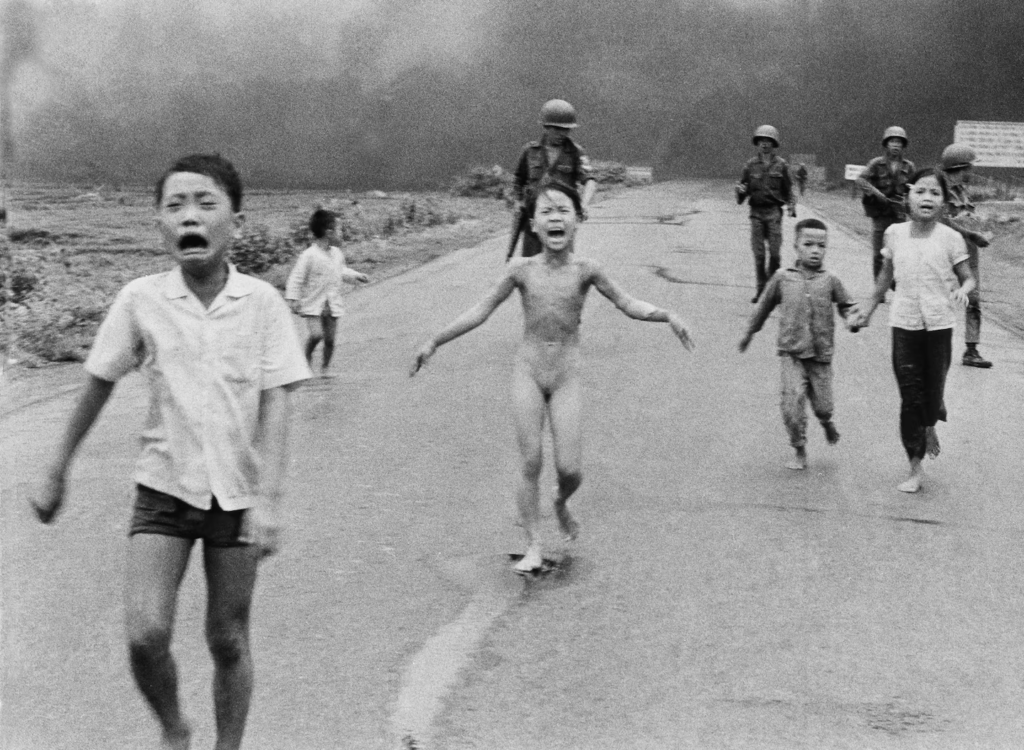
‘The Napalm Girl’, Nick Ut, 1972.
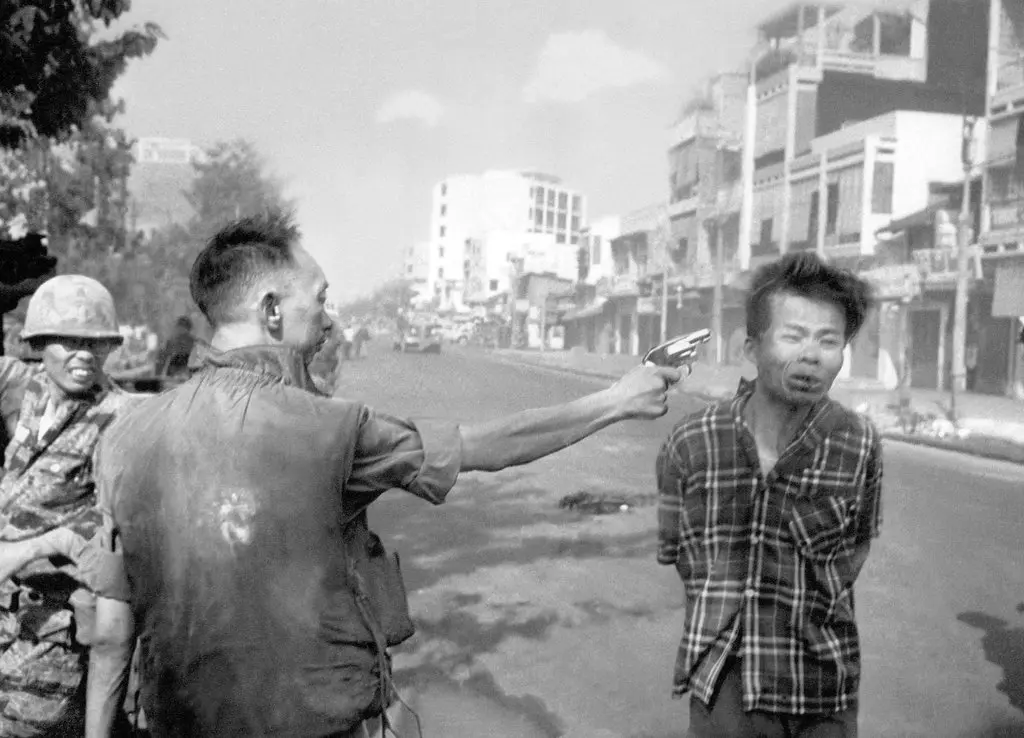
‘Death captured on camera’, Eddie Adams, 1968.
These images are compelling for the time as they showed the public the reality of ‘the enemy’; innocent people who were caught up in a war of politics and were facing the brunt of it. With all this in mind I find that despite the fixed mindset of ‘good vs evil’ people associate to a war, there is a deeper personal factor which often goes unrecognised within these conflicts, that is the people caught between it all, forced into these situations against their will. This is why I feel as tableaux approach is applicable, focusing on the subject matter of the personal lives, I wish to construct a narrative that people can follow to visually understand that these soldiers had their own lives too, not just the face of a hateful and oppressive regime. To quote Susan Sontag, ‘to photograph is to participate in another person’s mortality, vulnerability, mutability. Precisely by slicing out this moment and freezing, all photographs testify to times relentless melt.’4.
Paul M. Smith –
To depict the lives of the German Soldiers in a way that I found represented the realities or truth of war, I found that Paul M Smith’s work, aided me through his images. After serving as a regimental photographer in the royal engineers he displayed his own personal interpretation of his military experiences by creating images of himself cloned and dressed as soldiers being placed in scenarios, remnant of work such as Eddie Adams. Here I found inspiration into how he utilised photography to visualise the personal effects but also ubiquitous effects of wars reality.
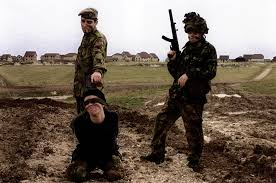
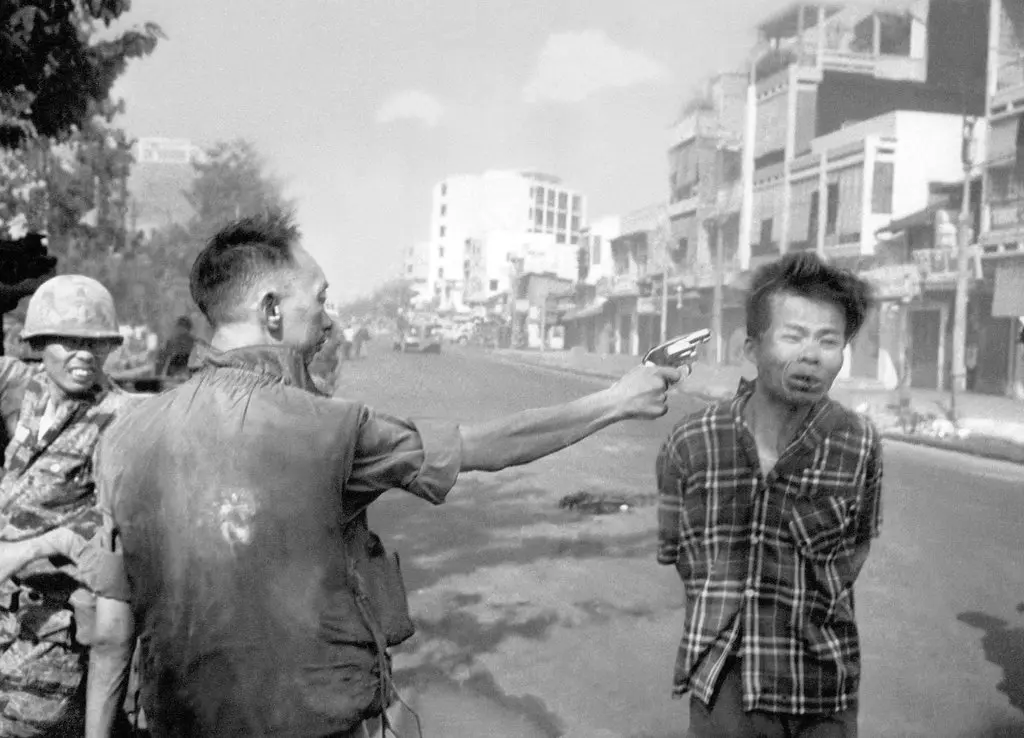
‘Artist Rifles’, Paul M Smith, 1997. + ‘Death captured on camera’, Eddie Adams, 1968.
In these depictions, Smith attempts the question, how can photography represent the realities or truth of war? Presenting his own military experiences in an interpretative tableaux, Smith’s work aims to ‘debate about the truthfulness of many battlefield photographs (such as) from the First and Second World War; some, which we now know were taken during training’5. Looking into this image in particular my work takes influence from the methods applied by Smith in his work.
Paul M. smiths influence:
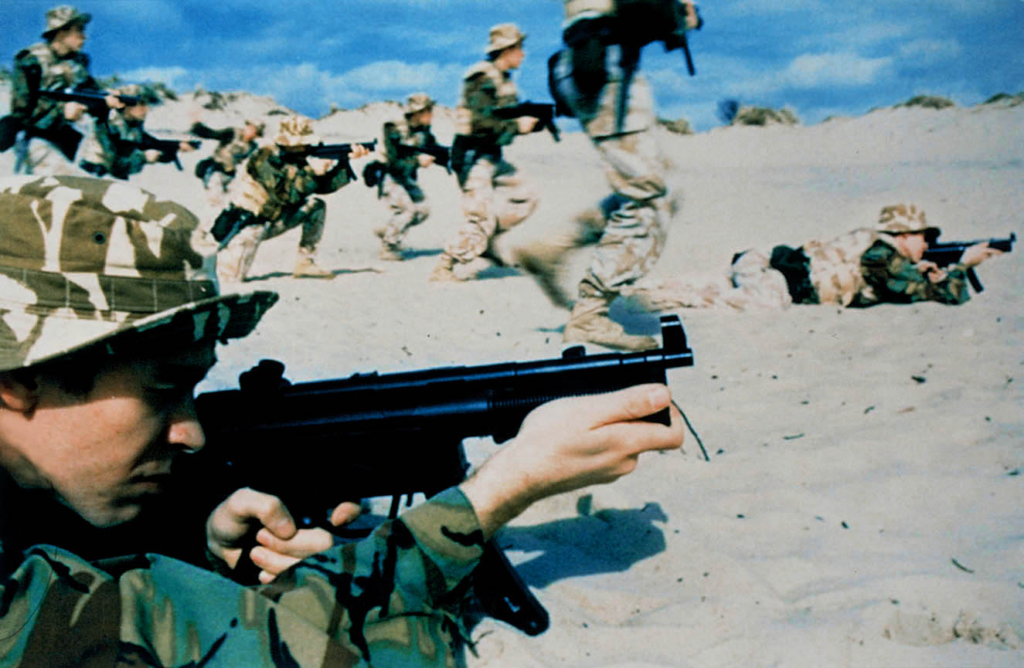
‘Artist Rifles’, 1997, Paul M Smith.
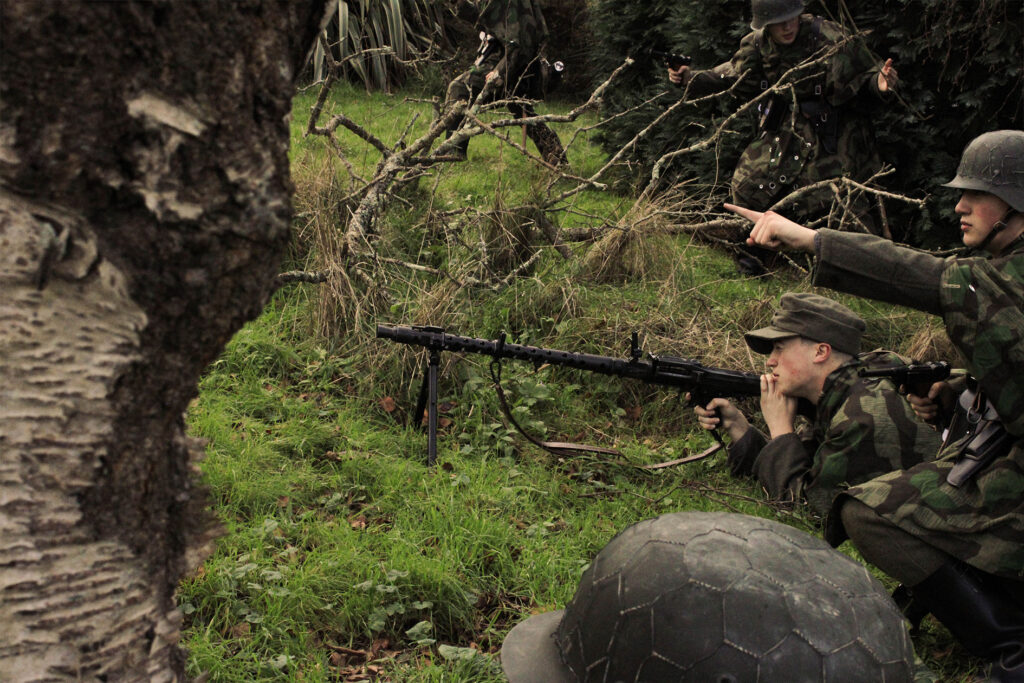
My example – ‘Combat Exercise’.
Within ‘Artist Rifles’, Smith refers ‘to the nature of war photography and its sometimes-dubious status in another battlefield, the Media’.6 With many famous images surrounding World War Two such as ‘Raising the Flag on Iwo Jima’ being misinterpreted or used as propaganda to display the victory of a battle, the reality of photographs circumstances can differ largely. With this picture for example, the flags raising was only within the first week of a thirty-six-day struggle to control the Island. With Nazi-Germany being a significant user of such intended misinterpretations, many of their images were staged to convey victory, this was the case with Jersey which they saw as the stepping stone to England. From this, Smith’s work challenges the concept of how photography depicts the reality and truth of wars through a modern tableaux with a genuine but also interpreted lens. Smith brings to light the issue of media and its ability to change the past through their own interpretations of photographs and how realities of wars can only be true for those who have experienced it or have been closely associated to it such as himself. This therefore explains why he focuses on himself as the subject to create this visual metaphor for his audience to understand.
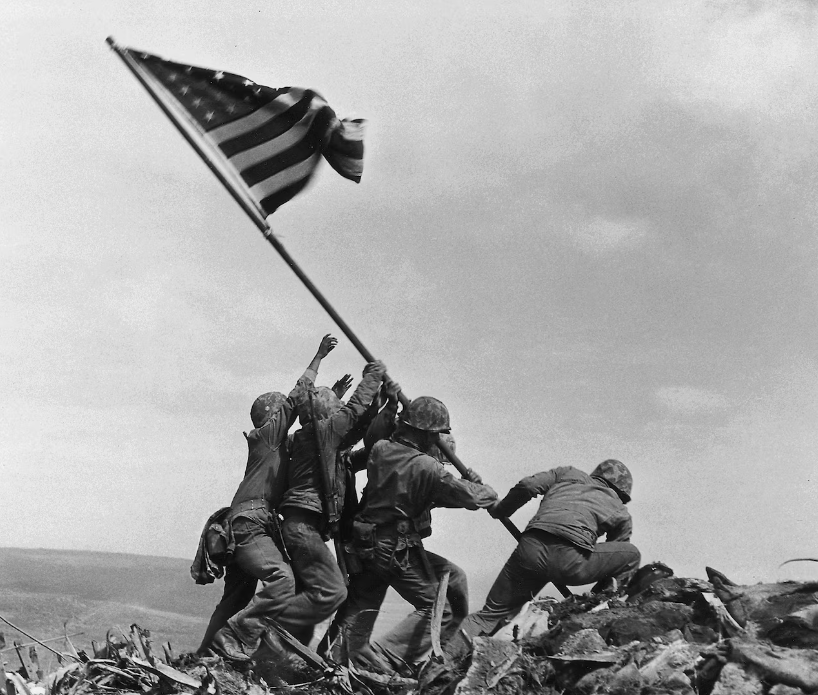
‘Raising the flag on Iwo Jima’, 1945, Joe Rosenthal.
With Smith’s work displaying a fabricated aesthetic of war, he created it through the method of using props such as weapons and various poses between his clones, to form the immersive environment you expect to see in images of conflict. In addition to this, the use of double staging adds to the immersion as his images themselves are of staged military training to simulate real-life warfare tactics. Smith pays homage to the type of imagery associated to warfare provided from many eras of war photography such as the ‘Robert Capa photography taken during the Spanish civil war’ ‘alluded to in Artist Rifles’7. From these historical references I used my research into the Germans of Corbiere, who themselves held training drills like this, to link to his methods of image constructing to make an indexical reference in my own work and construct the same aesthetic that his images have in conveying photography’s more fictitious side to war.
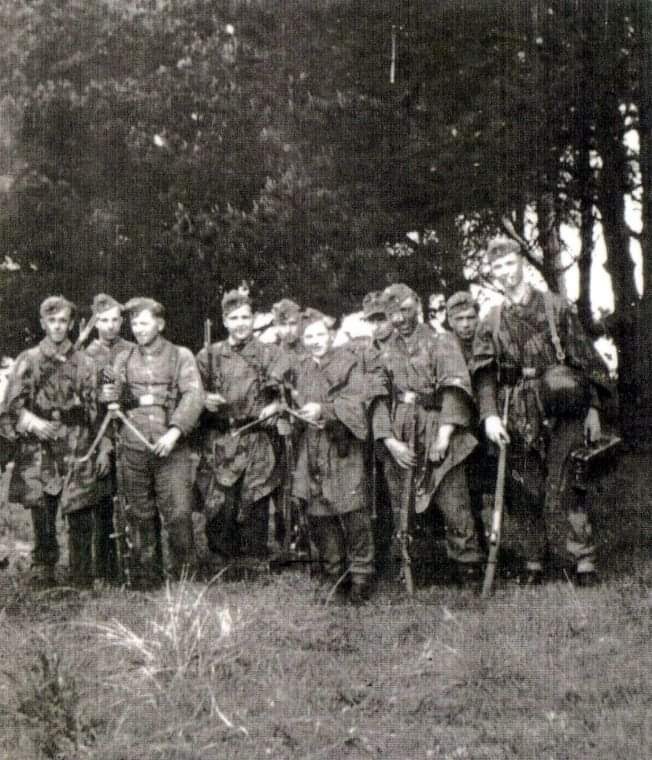
Reference Image – Germans of MG Battalion 16, 2nd Company on training.
Michiel Peeters –
In Michiel Peeters work, he makes use of genuine locations of historical significance for his visualisations of the Second World War. Using re-enactors dressed in accurate uniforms, portraying the actual groups which fought there, I found that this was applicable to my project to demonstrate our Islands local history, but also to provide an answer to the question, ‘How can photography represent the realities or truth of war?’. Focused on telling the stories of the individuals that were present in these places, Peeters makes extensive efforts for accuracy in things such as uniform details, vehicles and weather. From all of this, Peeters brings out an immersive aesthetic, reminiscent of the observational documentation present in photographs from that time, yet with an advantage of modern technology such as with camera quality and access to editing software.
Speaking to Peeters online, he told me that ‘the only correct way to capture the re-enactors is when you are next to them in the mud, snow, foxhole, tank, etc.’ ‘The only photographer I relate to from WW2 is Robert Capa with his famous quote ‘if your pictures are not good enough, you are not close enough!’.8 With Documentative photography having its roots in the illustrated photo magazines, popular from around the 1920s to 1940s, notable names included LIFE magazine which Robert Capa worked for during the war. Pictures featured in the magazines came from these correspondents being attached to the army as they fought through the war, their observational style reflective of the way Peeters conveys his images.
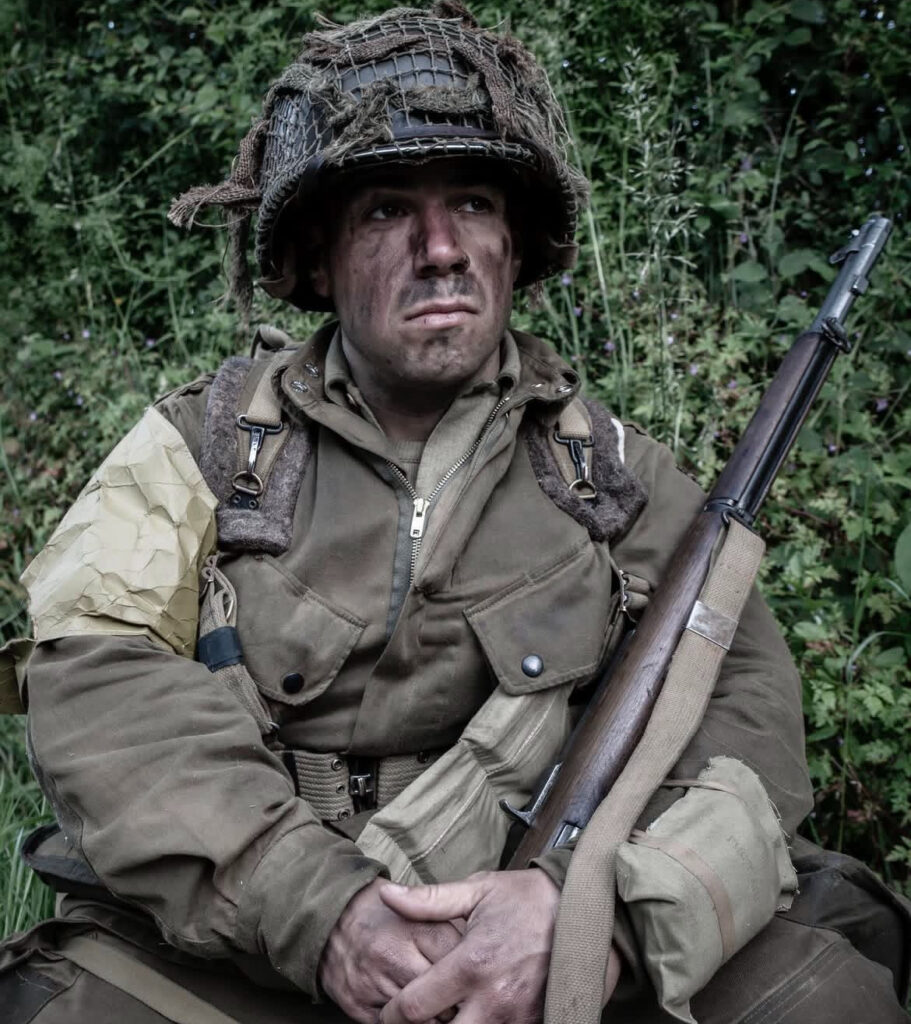
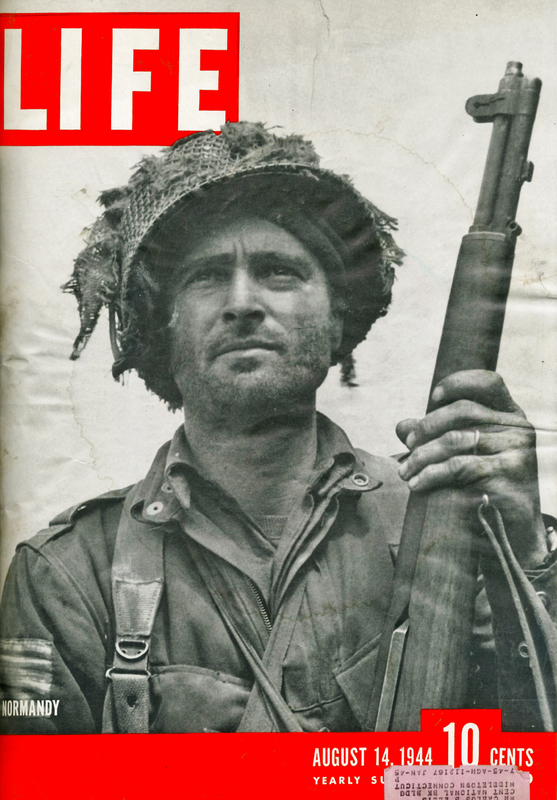
‘Faces of War!’, 2024, Michiel Peeters. + ‘LIFE, In Normandy.’, 1944, Bob Landry.
Although differing in terms of motivations and mise-en-scene to my other artist, Paul M Smith, Peeters also makes use of tableaux photography. Used in a documentative sense, his photography is used to represent the reality of war through recreating the people present as accurately as possible. Taking from historical resources such as archive photographs, this aids his image making progress to ensure as much detail is included. This echoes from tableaux’s initial use such as in theatres where it was used to create a ‘living picture’. 9 In the same way Peeters does the same to educate and entertain through his photography. For this reason, I find that Peeters presents photography as a tool to inform and educate the realities and truths of war, through a tableaux, dedicated to historical accuracy to provide immersion into this real event. With the choice to present them in a modern context, this adds to the immersion of portraying wars reality as it creates something we can see. As Sontag states, ‘photography makes us feel that world is more available than it really is’. 10
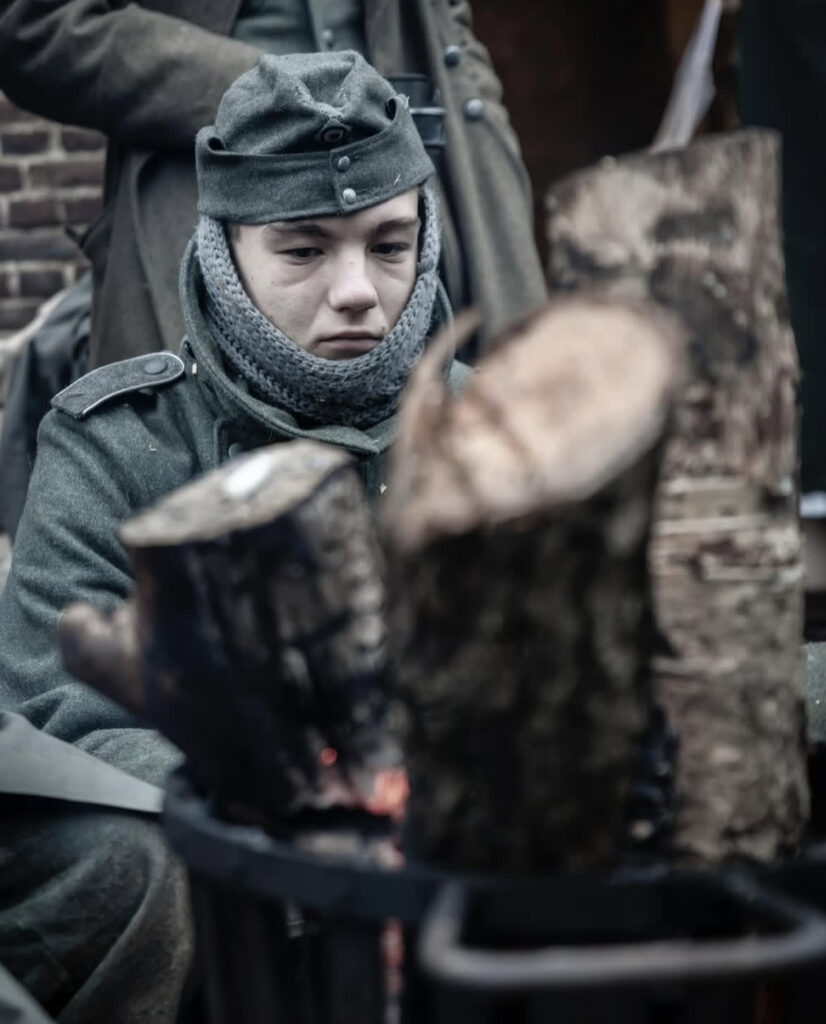
‘Windhund, 116th Panzer division’, 2024, Michiel Peeters.
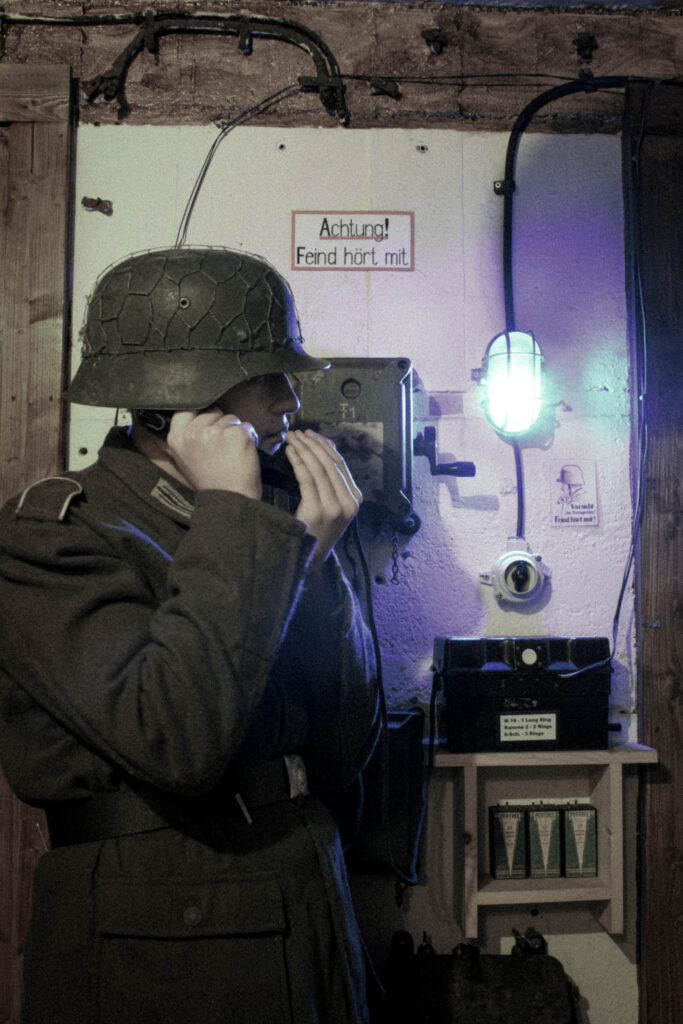
My example – ‘Achtung’.
For my project, I wish to combine the advantage of modern editing software to produce my images in the same way as Peeters with its lower saturation, tone and other adjustments to create that gritty realism his images represents. Replicating his image making process of being imbedded into the lives of the people he visualises; I copied this through close-up shots of me to make my uniform and appearance the focus. For my project I want to also create images with the same vintage aesthetic of originally taken images. Taking from Paul M. Smith’s inspired images, I can then apply the aesthetic of Peeters style of editing them to create a merger of the two.
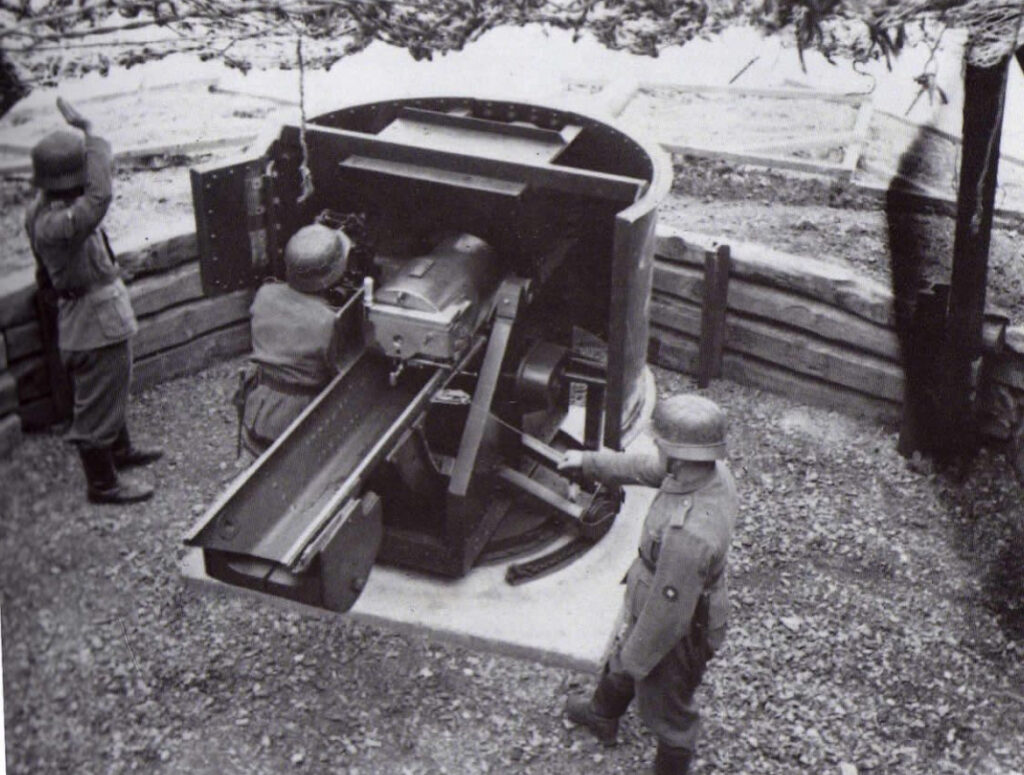
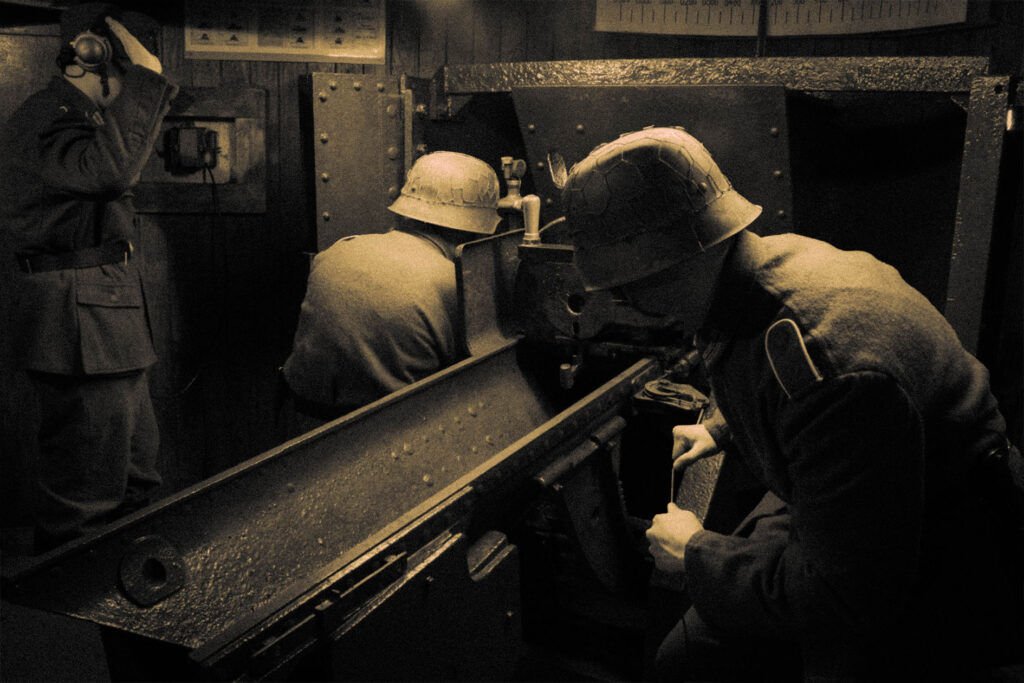
Reference Image – Early war photo of MG Battalion 16, 2nd Company, gun crew. + My Example, ‘Gun crew’.
In my study, I took the key points of my artist studies to influences and create an understanding of how photography can be used to represent the realities or truth of war. Despite wars various depictions, my artists; Paul M. Smith and Michiel Peeters, have taught me that the concept of war can be captured through photography in various ways, yet still portray the same meaning and sentiments. Where these artists can be seen to differ however is through their own interpretation of the subject. Paul M. Smith uses photography to retell his own perspective on war and through himself being the subject. He makes the point that the true reality of war is only experienced by those present within it and how media’s representation can often shift this fact through its own interpretations of it. In contrast to this, Michiel Peeters uses photography to educate on the history of war, and particularly those who had to go fight them.
Despite their different approaches, both contain the key point of bringing the reality of war to light, whether it be artistically like Smith or directly, in a documentary fashion such as Peeters. Furthermore, both artists make use of staged images within their photography to depict war and retell experiences of it. With photography being the largest source to provide visuals of war, it is understandable that the only way to recreate that is through tableaux’s depiction. As Susan Sontag states ‘photography has become one of the principal devices for experiencing something, for giving an appearance of participation’. 11
From what I have learnt from studying my artists, I have taken influence from Smith’s cloned use of himself as the subject to depict the personal lives of the many German soldiers of Jerseys occupation. My inspiration from Peeters came from the focus on historical accuracy in the right clothing, props and through details such as location where I photographed within the actual bunkers that the men of MG battalion 16, 2nd Company, served in. Furthermore, the focus on the Second World War was also a large influence from Peeters also. Taking from Smith’s use of photoshop, and Peeters edit style I combined these technical elements to create my final outcomes. With my focus documenting the lives of these soldiers, I used archive images to base my emotive language mainly in my face across some of the photographs, from these images I also tried to recreate them to the best of my ability. Through my work, I feel I have replicated the similar sentiments behind each of my artists work, and through a personal factor of my island’s history, I committed to informing about the lives of those stationed here and the often-ignored truth of wars reality for them.
Word count (without including quotations): 2444
Bibliography:
- S. Sontag – ‘Plato’s cave’ (1977) page 4 ↩︎
- Michiel Peeters (2024)- Direct quote from answer to my questions I sent him. ↩︎
- S. Sontag – ‘Plato’s cave’ (1977) page 18 ↩︎
- S. Sontag – ‘Plato’s cave’ 1977) page 15 ↩︎
- ‘Goliath’ – Paul M Smith (1977) (2004) – Introduction ‘ Stories of a young man’ by Paul Wombell ↩︎
- ‘Goliath’ – Paul M Smith (2004) – Introduction ‘ Stories of a young man’ by Paul Wombell ↩︎
- ‘Goliath’ – Paul M Smith (2004) – Introduction ‘ Stories of a young man’ by Paul Wombell ↩︎
- Michiel Peeters (2024) – Direct quotes from answers to my questions I sent him. + Robert Capa quote ↩︎
- A short PPT on Documentary Photography ↩︎
- S. Sontag – ‘Plato’s cave’ (1977) Page 24 ↩︎
- S.Sontag – ‘Plato’s cave’ (1977) page 10 ↩︎

George, overall a well formulated introduction, that sets out your reasons, interests and intentions with reference to second world war and artist case studies. However before you begin to write paragraph 1, make sure that you read key text in bibliography, esp, Sontag, Bate and Bright in order to gain more knowledge and better understanding of some of the issues at play as well as similarities and differences between documentary and tableaux photography. Make sure that you use direct quotes, reference contextual sources and comment on them, either agree or disagree to formulate a critical argument.
I’ve made some minor corrections directly in your text, but also left strikethrough text for you delete. Well done!
George, I have read through the entire essay and made some minor changes where needed. From my point of view, the essay is complete and you can submit a final versions, minus essay structure. Replace subheadings in red with Paul M. Smith, Michael Peeters etc.